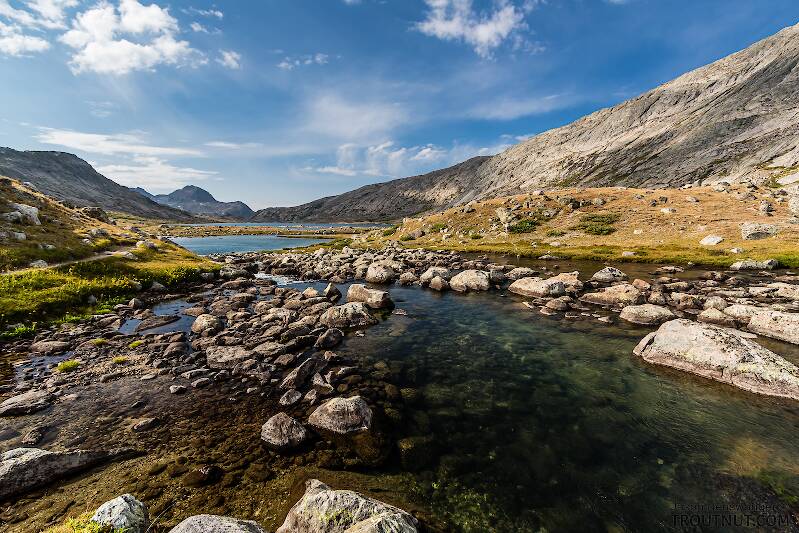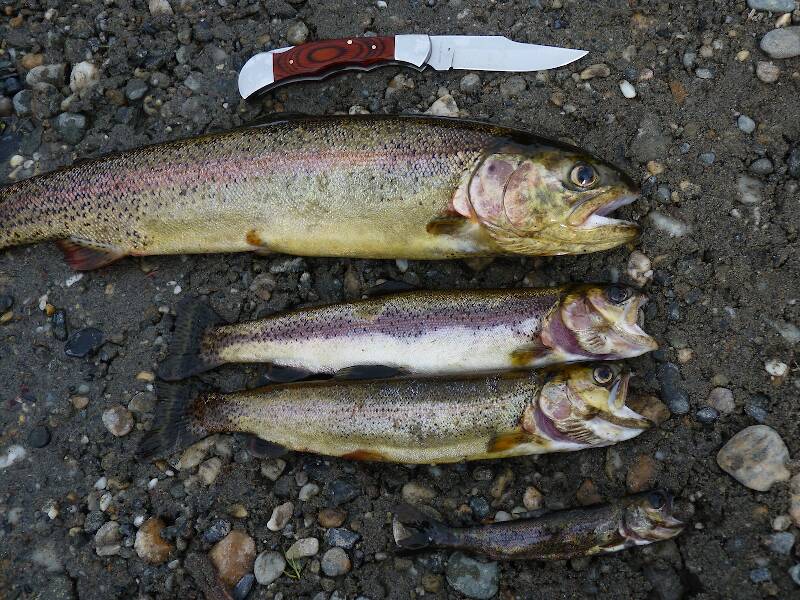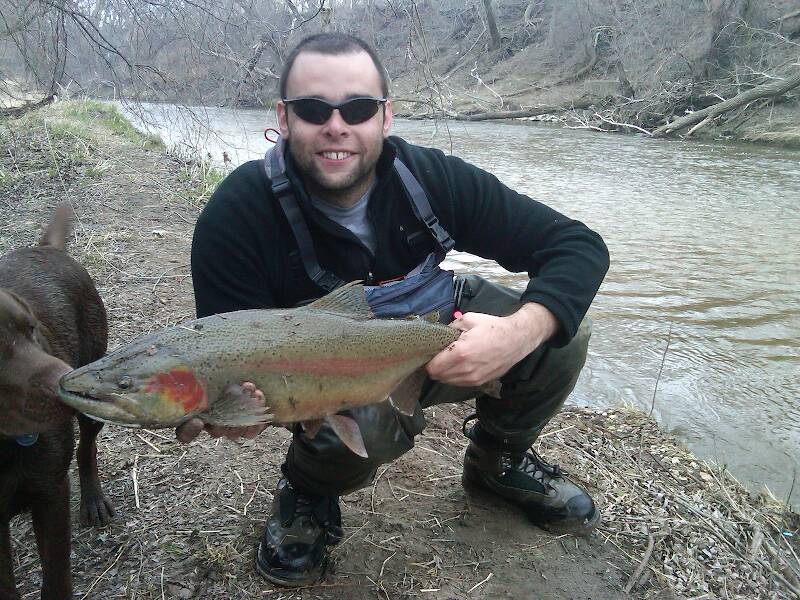
Blue-winged Olives
Baetis
Tiny Baetis mayflies are perhaps the most commonly encountered and imitated by anglers on all American trout streams due to their great abundance, widespread distribution, and trout-friendly emergence habits.
Featured on the forum

This wild-looking little thing completely puzzled me. At first I was thinking beetle or month larva, until I got a look at the pictures on the computer screen. I made a couple of incorrect guesses before entomologist Greg Courtney pointed me in the right direction with Psychodidae. He suggested a possible genus of Thornburghiella, but could not rule out some other members of the tribe Pericomini.

Troutnut is a project started in 2003 by salmonid ecologist Jason "Troutnut" Neuswanger to help anglers and
fly tyers unabashedly embrace the entomological side of the sport. Learn more about Troutnut or
support the project for an enhanced experience here.
GldstrmSam on Jul 12, 2013July 12th, 2013, 1:21 pm EDT
Hi Friends, I am possibly going on a fly-in pike fishing trip in a week. It is likely to Minto Flats.
Anyway it is my job to get together what we need for the trip. I have an idea of what to bring, but since I have not done this before I would like any other ideas.
I need to know some things that are absolutely necessary besides rod and reel. Some helpful things would be great fly patterns, leader help...
I am unofficially the "guide" so I don't want to let my friend down.
Thanks,
Samuel
Anyway it is my job to get together what we need for the trip. I have an idea of what to bring, but since I have not done this before I would like any other ideas.
I need to know some things that are absolutely necessary besides rod and reel. Some helpful things would be great fly patterns, leader help...
I am unofficially the "guide" so I don't want to let my friend down.
Thanks,
Samuel
There is no greater fan of fly fishing than the worm. ~Patrick F. McManus
Troutnut on Jul 12, 2013July 12th, 2013, 11:55 pm EDT
I did that trip in 2007 with my dad and had an awesome time.
It seemed the fishing was highly variable. We caught something like 75 pike, mostly in the 20-25 inch range, the biggest around 28 if I remember correctly. Another group flying out on the same plane with us said they only caught about 15 fish between 3-4 guys, but several of theirs were much bigger, 36-42 inches. The lesson learned is that the size and numbers of pike can differ dramatically depending on where you go in the flats, and maybe what tackle you use.
Fly patterns: something durable. You don't want to have to keep changing flies every time you catch a fish, and if you hit the right spot you might be catching a lot of small pike. Make sure you've got some decent surface flies because they're fun to fish, and some flashy subsurface stuff.
Locations: Look for places likely to have a slight current, or natural chokepoints and movement corridors. Lake inlets/outlets, stream junctions, etc. We did all our fishing in stream channels, focusing on features like this, and didn't venture out into the main water of the big lakes.
Leader: Definitely use a steel leader (and bring spares). As for the rest of the leader between the tippet and rod, I just used some stiff mono, pretty short (5 feet?) and only 1-2 diameters. Nothing fancy. The water's quite tea-stained so you don't have to worry about the fish being line-shy.
Take some pictures and let us know how it goes!
It seemed the fishing was highly variable. We caught something like 75 pike, mostly in the 20-25 inch range, the biggest around 28 if I remember correctly. Another group flying out on the same plane with us said they only caught about 15 fish between 3-4 guys, but several of theirs were much bigger, 36-42 inches. The lesson learned is that the size and numbers of pike can differ dramatically depending on where you go in the flats, and maybe what tackle you use.
Fly patterns: something durable. You don't want to have to keep changing flies every time you catch a fish, and if you hit the right spot you might be catching a lot of small pike. Make sure you've got some decent surface flies because they're fun to fish, and some flashy subsurface stuff.
Locations: Look for places likely to have a slight current, or natural chokepoints and movement corridors. Lake inlets/outlets, stream junctions, etc. We did all our fishing in stream channels, focusing on features like this, and didn't venture out into the main water of the big lakes.
Leader: Definitely use a steel leader (and bring spares). As for the rest of the leader between the tippet and rod, I just used some stiff mono, pretty short (5 feet?) and only 1-2 diameters. Nothing fancy. The water's quite tea-stained so you don't have to worry about the fish being line-shy.
Take some pictures and let us know how it goes!
Jason Neuswanger, Ph.D.
Troutnut and salmonid ecologist
Troutnut and salmonid ecologist
Gutcutter on Jul 13, 2013July 13th, 2013, 6:09 am EDT
Fly patterns: something durable. You don't want to have to keep changing flies every time you catch a fish, and if you hit the right spot you might be catching a lot of small pike.
Amen.
Puglisi style flies are a great choice. I tie them on size 2/0 and 3/0 saltwater hooks.
Make sure you've got some decent surface flies because they're fun to fish, and some flashy subsurface stuff.
Depending on the rod weight you are using, large surface flies can be a blessing or a curse. If your heaviest set up is an 8 wt, you will have a tough time throwing any kind of distance with an air resistant topwater pike fly - 8-12 inches. A 10 wt is a better choice for those. But "bass size" poppers and divers will take their fair share of pike, should you use a lighter set-up.
Leader: Definitely use a steel leader (and bring spares).
I disagree. 60 pound fluorocarbon will provide ample protection against the teeth of pike and muskies.
These fish-
43"Northern
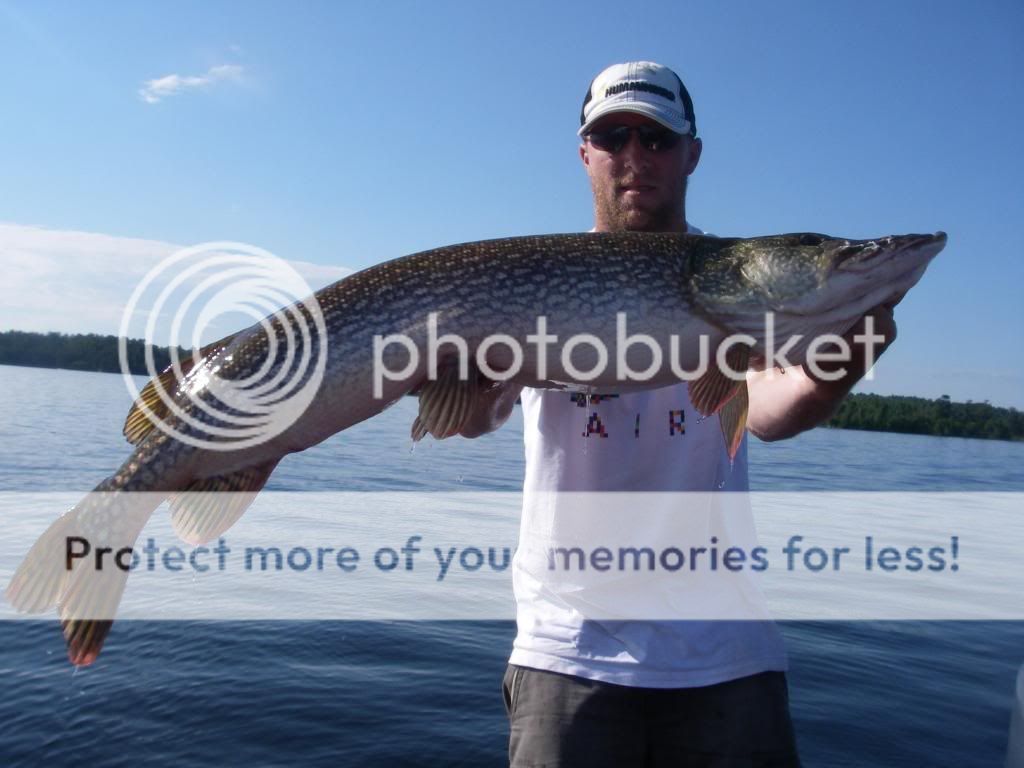
52"Muskie
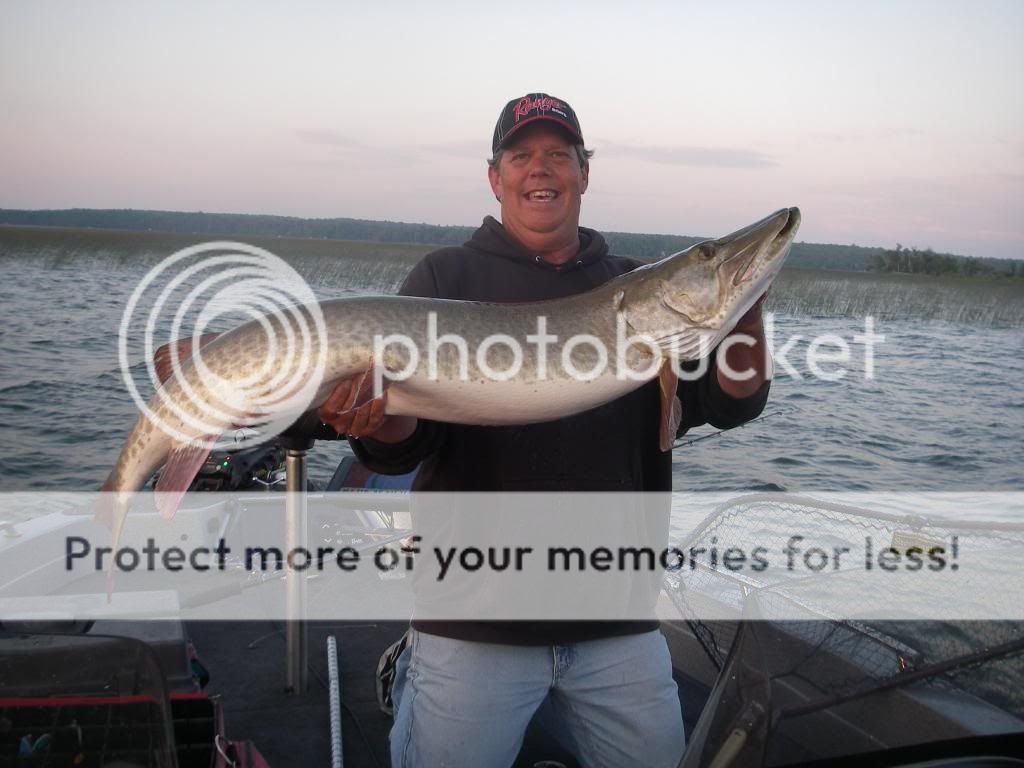
were taken last week on 60 pound fluoro.
As was this 80 pound tarpon taken last spring

As for the rest of the leader between the tippet and rod, I just used some stiff mono, pretty short (5 feet?) and only 1-2 diameters. Nothing fancy.
I use five feet of 50 pound Ande Big Game barrel knotted to 3 feet of 40 pound with a perfection loop at the end. The fluoro bite tippet is then perfection looped to the to the end of the 40 and secured to the fly with a uni knot.
Take some pictures and let us know how it goes!
Absolutely!
All men who fish may in turn be divided into two parts: those who fish for trout and those who don't. Trout fishermen are a race apart: they are a dedicated crew- indolent, improvident, and quietly mad.
-Robert Traver, Trout Madness
-Robert Traver, Trout Madness
GldstrmSam on Jul 13, 2013July 13th, 2013, 6:56 am EDT
Thanks Guys! That was a lot of help!
I will definitely try to take pictures... although that is one of my greatest weaknesses when I get to a good fishing spot.:)
You two really summed up a lot of good advise, but I will still take any other feed-back anyone else has.
Samuel
I will definitely try to take pictures... although that is one of my greatest weaknesses when I get to a good fishing spot.:)
You two really summed up a lot of good advise, but I will still take any other feed-back anyone else has.
Samuel
There is no greater fan of fly fishing than the worm. ~Patrick F. McManus
Troutnut on Jul 13, 2013July 13th, 2013, 10:32 am EDT
If your heaviest set up is an 8 wt, you will have a tough time throwing any kind of distance with an air resistant topwater pike fly - 8-12 inches.
Distance isn't needed at all in this particular area. Most casts are very short.
In the best spot we found when I fished it, I was even somewhat afraid to stick my hand in the water. Pike were hitting anything that moved instantly. I could have caught ten of them using a few feet of mono and no rod. Hopefully Sam hits a spot or two like that.
I disagree. 60 pound fluorocarbon will provide ample protection against the teeth of pike and muskies.
I've heard that can be great, too, but haven't tested it enough myself. I know others who use fluoro for big pike and muskies, but how well does it hold up if you catch 45 little ones? Maybe fine, I just don't know.
Jason Neuswanger, Ph.D.
Troutnut and salmonid ecologist
Troutnut and salmonid ecologist
Kschaefer3 on Jul 15, 2013July 15th, 2013, 5:07 am EDT
I agree on the 60 lb flouro. I fish musky with a similar setup and have never had issues. Even if you don't need to cast far, a 10 wt would make your arm happy at the end of the day. I haven't started tying big stuff like that yet, but big deceivers, divers and poppers all work. I like articulated flies for musky a lot of times.
http://flyobsession.com/?tag=nick-granato
Some good flies on the link above.
http://flyobsession.com/?tag=nick-granato
Some good flies on the link above.
Oldredbarn on Jul 15, 2013July 15th, 2013, 7:02 am EDT
Wow Tony! Getting it down man! Nice fish...I don't target Pike but caught one through the ice once that was 26"...A small nighttime snack for your fish. :)
A mere guppy in comparison.
You are the "complete angler"...Salt, Pike, and a master with a midge rod...
Spence
Northern alligators!
Hey! Your boat partner...He's not wearing a Rangers cap is he...I'm surprised you didn't push him in!
A mere guppy in comparison.
You are the "complete angler"...Salt, Pike, and a master with a midge rod...
Spence
Northern alligators!
Hey! Your boat partner...He's not wearing a Rangers cap is he...I'm surprised you didn't push him in!
"Even when my best efforts fail it's a satisfying challenge, and that, after all, is the essence of fly fishing." -Chauncy Lively
"Envy not the man who lives beside the river, but the man the river flows through." Joseph T Heywood
"Envy not the man who lives beside the river, but the man the river flows through." Joseph T Heywood
Entoman on Jul 15, 2013July 15th, 2013, 11:19 am EDT
Hi Sam,
During my Summers in AK, most of the fishing I did for myself was for Pike after work. Love that fish!!! My input is dated, but some of my experience may prove helpful. In those years (70's), the pike were measured in pounds not inches. It was the rare day where one over ten pounds wasn't brought to hand and there were hundreds of them over the season.
Fluoro is a bit pricey. If that is an issue, a $3 spool of 40 lb Maxima will get the job done. Landed many, many over 15 lbs. and never had one cut it. Don't go heavier than 15 lb Maxima somewhere in the leader unless you want a broken fly line in a snag (lazy anglers that wouldn't listen to this tried it once only). For bigger pike (over 10 lbs) 3/0 hooks work better than large trout streamer hooks, as does a subtle sideways sweep of the rod in conjunction with a strong haul. You need much more hand than rod and you need to hit them more than once if they don't turn away on the take. I've seen lots of fish missed because of the use of #2 trout streamer hooks and trout hook sets. The bigger hooks make release easier as well.
I fished for them mostly prior to the advent of Boca grips, fluoro and kevlar gloves. Those are vast improvements, but I've seen hundreds of big pike effectively landed and released without harm to fish or human using canvass gloves and long handled needle nose pliers. A lot of old timers used to handle them by grabbing them by the eyes. They do stop thrashing and pop their mouths open nicely. It was claimed no harm was done to the fish and safer (for both angler and fish) than those monsters thrashing in the boat or net. While an effective way to subdue them, I have to believe that it can't be good for a predator that heavily depends on it's vision. I wouldn't do it. It takes 75 years or so to grow really big Pike in AK. They are a precious resource... What are your thoughts on the practice, Jason?
As for getting them to take a fly, I observed the following:
1. Sometimes they prefer a fast stripped streamer, sometimes a deer hair popper on the surface. Be prepared for both. On still water, I usually started with the popper first.
2. No need to go with the outsized flies as used for Muskie. I preferred flies in the 4" to 6" range. Safer and easier to cast.:)
2. No need to go with the garish popper patterns popular with bass. Natural deer hair looks more like a little mammal swimming where it shouldn't and were usually much more effective. Perhaps because there aren't a lot of colorful amphibians in AK? Regardless, Pike aren't into color as much as bass.
3. The presentation is vital, especially over fish that have seen a fly or two. I liked to let the popper sit after the cast until the rings dissapated and then started the retrieve. Experiment with different pauses and strips. A jerky fast retrieve is also sometimes effective. You have to tease the big boys. It's kind of the angling version of calling ducks or turkey.
4. Streamers can be brighter and more garish, but I also found that simple baitfish imitations usually worked better. I carried a few Mickey Finn types, but mostly fished simple bucktails of blue over white and green over white. The bushier the better. Mine were tied Brooks Blonde style. Silver mylar braid body with a big hank of white hair coming out of the middle of the shank and a contrasting color at the head. I experimented with strips of flash in the hair, but found the fish sometimes turned away at the last second. Perhaps a flash at the wrong time spooked them? Don't over-do that stuff. The vast improvements in saltwater flies since then are undoubtedly effective, probably more so. But, they are much more expensive in time and money to tie.
5. In still water they are found along lily pad and grass edges and holes in the beds. Be especially stealthy around points (where the beds indent or jut out into open water); the big boys like those spots...
6. In streams, look for structure as with any large predator, but be especially mindful of structure at the leading edge at the top of a pool (on the slow side). They love to face upstream hidden by cover so they can turn and use the current speed to pounce on anything that would drop into the pool from behind.
7. Similar structure at inlets and outlets are also their favorite hunting grounds.
Hope this helps. Good luck on your trip!
During my Summers in AK, most of the fishing I did for myself was for Pike after work. Love that fish!!! My input is dated, but some of my experience may prove helpful. In those years (70's), the pike were measured in pounds not inches. It was the rare day where one over ten pounds wasn't brought to hand and there were hundreds of them over the season.
Fluoro is a bit pricey. If that is an issue, a $3 spool of 40 lb Maxima will get the job done. Landed many, many over 15 lbs. and never had one cut it. Don't go heavier than 15 lb Maxima somewhere in the leader unless you want a broken fly line in a snag (lazy anglers that wouldn't listen to this tried it once only). For bigger pike (over 10 lbs) 3/0 hooks work better than large trout streamer hooks, as does a subtle sideways sweep of the rod in conjunction with a strong haul. You need much more hand than rod and you need to hit them more than once if they don't turn away on the take. I've seen lots of fish missed because of the use of #2 trout streamer hooks and trout hook sets. The bigger hooks make release easier as well.
I fished for them mostly prior to the advent of Boca grips, fluoro and kevlar gloves. Those are vast improvements, but I've seen hundreds of big pike effectively landed and released without harm to fish or human using canvass gloves and long handled needle nose pliers. A lot of old timers used to handle them by grabbing them by the eyes. They do stop thrashing and pop their mouths open nicely. It was claimed no harm was done to the fish and safer (for both angler and fish) than those monsters thrashing in the boat or net. While an effective way to subdue them, I have to believe that it can't be good for a predator that heavily depends on it's vision. I wouldn't do it. It takes 75 years or so to grow really big Pike in AK. They are a precious resource... What are your thoughts on the practice, Jason?
As for getting them to take a fly, I observed the following:
1. Sometimes they prefer a fast stripped streamer, sometimes a deer hair popper on the surface. Be prepared for both. On still water, I usually started with the popper first.
2. No need to go with the outsized flies as used for Muskie. I preferred flies in the 4" to 6" range. Safer and easier to cast.:)
2. No need to go with the garish popper patterns popular with bass. Natural deer hair looks more like a little mammal swimming where it shouldn't and were usually much more effective. Perhaps because there aren't a lot of colorful amphibians in AK? Regardless, Pike aren't into color as much as bass.
3. The presentation is vital, especially over fish that have seen a fly or two. I liked to let the popper sit after the cast until the rings dissapated and then started the retrieve. Experiment with different pauses and strips. A jerky fast retrieve is also sometimes effective. You have to tease the big boys. It's kind of the angling version of calling ducks or turkey.
4. Streamers can be brighter and more garish, but I also found that simple baitfish imitations usually worked better. I carried a few Mickey Finn types, but mostly fished simple bucktails of blue over white and green over white. The bushier the better. Mine were tied Brooks Blonde style. Silver mylar braid body with a big hank of white hair coming out of the middle of the shank and a contrasting color at the head. I experimented with strips of flash in the hair, but found the fish sometimes turned away at the last second. Perhaps a flash at the wrong time spooked them? Don't over-do that stuff. The vast improvements in saltwater flies since then are undoubtedly effective, probably more so. But, they are much more expensive in time and money to tie.
5. In still water they are found along lily pad and grass edges and holes in the beds. Be especially stealthy around points (where the beds indent or jut out into open water); the big boys like those spots...
6. In streams, look for structure as with any large predator, but be especially mindful of structure at the leading edge at the top of a pool (on the slow side). They love to face upstream hidden by cover so they can turn and use the current speed to pounce on anything that would drop into the pool from behind.
7. Similar structure at inlets and outlets are also their favorite hunting grounds.
Hope this helps. Good luck on your trip!
"It's not that I find fishing so important, it's just that I find all other endeavors of Man equally unimportant... And not nearly as much fun!" Robert Traver, Anatomy of a Fisherman
Gutcutter on Jul 15, 2013July 15th, 2013, 12:13 pm EDT
Your boat partner...He's not wearing a Rangers cap is he...I'm surprised you didn't push him in!
Ranger, not Rangers. Like his boat.
Ron's older son was drafted by the Pens, and his younger boy played for your Knights.
He would never wear Blue Shirt gear...
All men who fish may in turn be divided into two parts: those who fish for trout and those who don't. Trout fishermen are a race apart: they are a dedicated crew- indolent, improvident, and quietly mad.
-Robert Traver, Trout Madness
-Robert Traver, Trout Madness
Oldredbarn on Jul 15, 2013July 15th, 2013, 6:26 pm EDT
Ranger, not Rangers. Like his boat.
Ron's older son was drafted by the Pens, and his younger boy played for your Knights.
He would never wear Blue Shirt gear...
I guess you can tell I don't know squat about boats. :) Sorry about that.
Spence
Knights are in London Ontario...Our local junior team's the Plymouth Whalers...morphed from our Junior Wings, and the Ambassadors (after the Ambassador Bridge)...Owed by Karmanos (Compuware)...He actually owned the Windsor Spitfires back in the 80's when I was going to games over there.
They, the Whaler's, got their name from when Karmanos owned the Hartford Whaler's...now Carolina.
Karmanos is the guy who gave Lindros a place to play after he screwed over the Greyhounds way back when before he screwed over Quebec...
"Even when my best efforts fail it's a satisfying challenge, and that, after all, is the essence of fly fishing." -Chauncy Lively
"Envy not the man who lives beside the river, but the man the river flows through." Joseph T Heywood
"Envy not the man who lives beside the river, but the man the river flows through." Joseph T Heywood
GldstrmSam on Jul 17, 2013July 17th, 2013, 4:15 pm EDT
Thank you all so much for your help. Very unfortunately the friend I was going to go with was unexpectedly called back to work so this trip fell through. But let me assure you that your help was not in vain. This is a topic I have been wanting to research for a long time.
Samuel
Samuel
There is no greater fan of fly fishing than the worm. ~Patrick F. McManus
Quick Reply
Related Discussions
Topic
Replies
Last Reply
0
Jun 21, 2009
by Minaanowak
by Minaanowak

